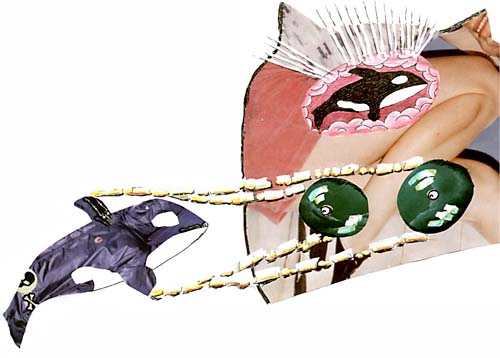
|
Lorna Mills and Sally McKay
Digital Media Tree this blog's archive OVVLvverk Lorna Mills: Artworks / Persona Volare / contact Sally McKay: GIFS / cv and contact |
View current page
...more recent posts
The Cultural Gutter by Guy Leshinski, Jim Munroe, and James Schellenberg is new, blogstyle and fun. Here's a good quote about computer games (and tap water) by JM:
"In the move from the arcade to the basement, we've lost more than bragging rights. The seedy-cool image of hanging out at the arcade -- which perhaps jump-started the gaming industry -- was traded in for a bland suburban model. Like a lot of shifts from the public to the private, the convenience and control we've gained is at the expense of certain intangibles. While hardly as ominous or significant a trend as bottled water undermining our public water system, these social shifts are both largely instigated by marketing pushes."
Touching the Void (SPOILERS): This is a documentary about mountain climbers Joe Simpson and Simon Yates. Lot's of things go wrong, and at one point Simon is forced to cut the rope, dropping the dangling Joe off the edge of a cliff. The big question of the movie: why does this guy stay alive? My favourite part is when the rope has been cut, and Simpson has fallen partway into the crevasse. He is sitting at the top of an open, gaping, black void. Rather than spend the next 4 days sitting there slowly dying, he decides to lower himself into the blackness. How great is that!? Down he goes, and sure enough there is a way out once he gets to the bottom. It's much too symbolically tidy to actually be a true story! Which brings me to the other thing I liked about the film...its very well crafted narrative. The re-enactments by the actor/climbers were sewn in tightly with the voice-over of the real climbers - there was no duplication of information, and a seamless emotional tone. I became aware of the fact that this story has been told many many times. The guys themselves must be constructing it in their memories, and the book, the lecture circuit, the film, all help to mold into its current, iconic shape.
Kevin Macdonald made the movie. As it went on, it became more mannered. Normally I'd be uncomfortable with that (as with Erroll Morris and his slo-mo coffee cups) but in this case it worked out just fine. I loved the final scenes where Simpson is losing his mind and can't get Boney M out of his head. The film and audio became fragmented, broken and chaotic and it was great. Another powerful visual moment was the closeup of his mouth sucking water from the rock. Sex, death, human in an environment where he does not belong. Sucking up a small muddly water puddle like he was going down on pussy.
One night towards the end he is lying on his back staring up at the stars. He begins to feel as if he has been there for millenia, as if he is part of the rock.
You could tell instantly from their faces which guy (Simon Yates) had cut the rope (and never forgiven himself), and which (Joe Simpson) had miraculously survived (and forgiven his friend for cutting the rope). Simon had darkness in his face and Joe had light (too perky by half).


Curator and international art collector Ydessa Hendeles is blowing me away these days. The quotes below are from a CBC broadcast of her presentation at Making History, a recent symposium in Toronto about Canadian art and its role on the international stage. I put up an mp3 of the broacast here. (Thanks for the recording, J!)
It is not only possible, but critical for Canadians to build relationships with artists and curators outside our national borders. It is the nature of expression to have urgency, and seek out as large an audience as possible. [...] I don't mean that artists should look for their audience in a careerist, strategic way. [...] Relationships work best when works are authentic expressions that are not made for strategic purposes of capitalising on already existing subjects of discourse.
[...] Museums in each country should not all have the same art in them.
[...] Some collecting museums, to resolve the issue of timeliness, have resorted to showing prominent private collections. But this has recently backfired. Indeed, the collecting museum's authority can easily be corrupted by the marketplace. For example, the display of the Saatchi collection of the show Sensation resulted in a scandal at the Brooklyn museum. [...] The persistent controversial issue is the commerical gain later won by the collector, as his works were subsequently put up for sale and made huge profits. The trustees of the Museum of Modern Art and Tate Gallery, both major collecting museums, responded by taking the position that they will not show a private collector's art collection. [...] Like the separation of church and state, there is, and should be, a boundary between commerce and art. Neither a collector, nor a corporation should be able to capitalize financially from the sale of a collection that comes directly from being promoted by a public museum.
 Image by Michael Breslin of the UofT Varsity, taken from here |
The death of activist Tooker Gomberg is a huge loss. His inspirational drive, imagination, and natural leadership accomplished a great deal for environmental activism and social justice. The shallow coverage in today's Globe and Mail is indicative of the fact that Gomberg knew how to get under the mainstream media's skin. Tooker was all justice all the time, and his media "stunts" raised awarness about poverty, smog, cycling, and political representation, as well as massively important global environmental issues. He will be badly missed. |